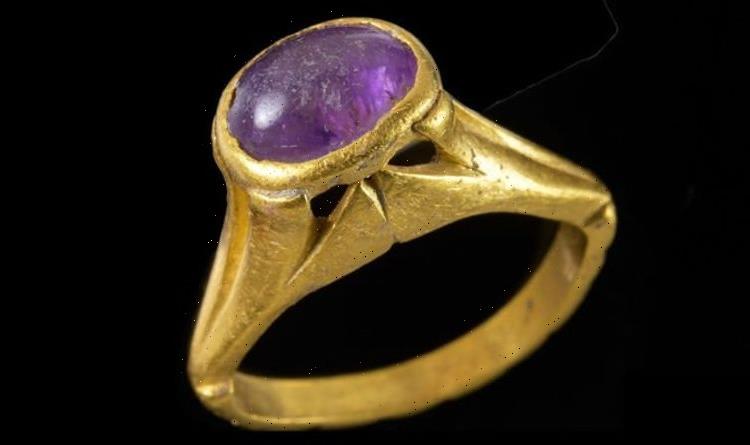Israel Antiquities Authority discovers Byzantine-era wine press
We use your sign-up to provide content in ways you’ve consented to and to improve our understanding of you. This may include adverts from us and 3rd parties based on our understanding. You can unsubscribe at any time. More info
According to the Israel Antiquities Authority (IAA), the bejewelled trinket was found at a dig site in the city of Yavne, just south of Tel Aviv. Last month, the IAA had revealed the city was being excavated ahead of its planned expansion, which has led to the discovery of a Byzantine-era (330 to 1453 AD) winemaking hub. The IAA wrote in a Facebook post: “A spectacular gold ring set with amethyst was discovered during Israel Antiquities Authority excavations at the world’s largest ancient wine factory in Yavne.”
Dr Amir Golani, the IAA’s resident expert in ancient jewellery, believes the ring may have once belonged to a wealthy individual of high status.
Wearing such an item would have been a clear indicator of personal wealth and prestige.
However, the experts have so far been unable to precisely date the object.
Although it would stand to reason it hails from the Late Byzantine to Early Islamic period in the seventh century, it may have been passed down over the generations.


The IAA added: “In fact, gold amethysts rings were common in the Roman world; therefore, the ring may have even been passed down from a wealthy person who lived in Yavneh as early as the third century AD.”
But what is more intriguing is the violet amethyst laid into the ring.
According to the IAA, amethyst is mentioned in the Bible as one of the 12 gemstones set into the breastplate of the Jewish High Priest.
The Biblical word for amethysts is derived from the Hebrew word achlamah, which means “dream stone”.
The Old Testament’s Book of Exodus describes the garments worn by the High Priest, including the various gems on his breastplate.
Israeli excavators uncover hundreds of liquor bottles from WWI
Exodus 39 reads: “And mounting on it a setting of gemstones, four rows of stones:
“In the first row there shall be a ruby, a topaz, and an emerald;
“In the second row a turquoise, a sapphire, and a diamond;
“In the third row a jacinth, an agate, and an amethyst;
“And in the fourth row a beryl, an onyx, and a jasper.”
According to the IAA, the ring’s discovery at Yavne may have had something to do with its supposed powers.


The archaeology group said: “Many virtues have been associated with this gem, including preventing hangovers, which is ironic as the ring was discovered near the Byzantine wine factory.”
At the height of its power, the Yavne wine hub is estimated to have produced up to 520,000 gallons or two million litres of wine a year.
The site was known for producing a type of wine that was called Gaza or Ashkelon Win.
The IAA said the drink was known internationally, with its fame reaching far into Africa and Europe.
Excavations at the site have revealed an impressive wine-making complex with five presses, warehouses and kilns used for the burning of clay vessels or amphorae.
In a video published by the IAA, Jon Seligman, one of the project’s leading excavators, said this would have been a prestigious product.
He said: “It was a light white wine and it was taken to many, many countries around the Mediterranean.
“We’re talking Egypt, we’re talking Turkey, we’re talking Greece, maybe to southern Italy as well.
“So this was a wine that was widely distributed around the Mediterranean.”
Source: Read Full Article
